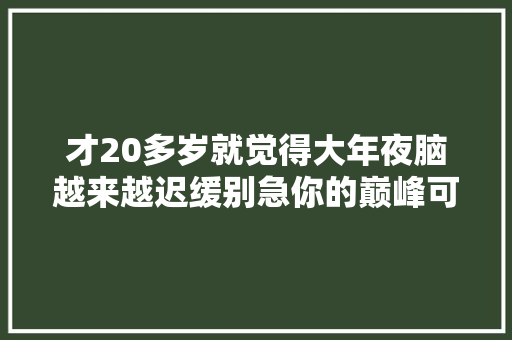你假如认为伟大的科学家年轻时最具有创造力,那么你可能只说对了一部分。
A new study of winners of the Nobel Prize in economics finds that there are two different life cycles of creativity, one that hits some people early in their career and another that more often strikes later in life.

一项关于历届诺贝尔经济学奖得主的新研究创造,人们有两段不同的创作生命周期:一段涌如今职业发展早期,而另一段每每涌如今生命的后期。
In this study, the early peak was found for laureates in their mid-20s and the later peak for those in their mid-50s.
这项研究创造,获奖者的年事分布存在两个高峰值,即25岁旁边和55岁旁边。
The research supports previous work by the authors that found similar patterns in the arts and other sciences.
此前在艺术和其它科学领域的研究结果,与这次研究结论相似。
\"大众We believe what we found in this study isn't limited to economics, but could apply to creativity more generally,\"大众 said Bruce Weinberg, lead author of the study and professor of economics at The Ohio State University.
“我们认为,研究成果不仅仅局限于经济学领域,还可以适用于普遍的创新活动,”该研究的紧张作者,俄亥俄州立大学经济学教授布鲁斯·温伯格说。
\"大众Many people believe that creativity is exclusively associated with youth, but it really depends on what kind of creativity you're talking about.\"大众
“很多人以为,创造力只与年轻人有关。实际上,这取决于何种创造力。”
Weinberg did the study with David Galenson, professor of economics at the University of Chicago. In the study, the Nobel Prize winners who did their most groundbreaking work early in their career tended to be \"大众conceptual\"大众 innovators.
温伯格与芝加哥大学经济学教授戴维·加伦森互助完成了这项研究。在职业生涯早期阶段实现领域打破的诺贝尔奖得主每每是“观点式”创新者。
These type of innovators \"大众think outside the box,\公众 challenging conventional wisdom and tend to come up with new ideas suddenly. Conceptual innovators tend to peak early in their careers, before they become immersed in the already accepted theories of the field, Weinberg said.
这一类型的创新者每每不拘一格,灵光乍现。温伯格说,在职业生涯早期实现顶峰的观点式创新者常日会在完备接管现有理论之前,寻衅传统聪慧。
But there is another kind of creativity, he said, which is found among \"大众experimental\公众 innovators.
但是温伯格认为,还有另一种创新路径,适用于“履历式”创新者。
These innovators accumulate knowledge through their careers and find groundbreaking ways to analyze, interpret and synthesize that information into new ways of understanding.
这类创新者会不断在自己的职业生涯中积累知识,综合过往信息找到全新的角度剖析、阐明问题。
The long periods of trial and error required for important experimental innovations make them tend to occur late in a Nobel laureate's career.
主要的实验创新打破每每须要长期反复试错。这一类创新每每涌如今诺贝尔奖得主职业生涯的后期。
\"大众Whether you hit your creative peak early or late in your career depends on whether you have a conceptual or experimental approach,\公众 Weinberg said.
“你在职业生涯中达到创造力顶峰的早晚取决于你习气于哪一种研究路径,观点式还是履历式,”温伯格称。
The researchers took a novel, empirical approach to the study, which involved 31 laureates. They arranged the laureates on a list from the most experimental to most conceptual.
研究职员采取了一种新颖的履历性研究方法。他们将31位诺贝尔奖得主按照从最“履历式”到最“观点式”的规则进行排序。
This ranking was based on specific, objective characteristics of the laureates' single most important work that are indicative of a conceptual or experimental approach.
该排序是基于获奖者的代表作(仅限一个)的详细客不雅观特色,表明了其观点式或履历式研究路径。
For example, conceptual economists tend to use assumptions, proofs and equations and have a mathematical appendix or introduction to their papers.
例如,观点式经济学家每每方向于在论文中利用假设、证明和方程,并附有数学附录或先容。
Experimental economists rely on direct inference from facts, so their papers tended to have more references to specific items, such as places, time periods and industries or commodities.
履历式经济学家则依赖于事实的直接推论,因此他们的论文每每更多提及特定项目,例如地点、韶光、行业或商品。
After classifying the laureates, the researchers determined the age at which each laureate made his most important contribution to economics and could be considered at his creative peak.
在对诺贝尔奖得主进行分类后,研究职员确定了每位获奖者对经济学做出最卓越贡献的年事。这一期间可被认为是他的创造顶峰。
Weinberg and Galenson used two different methods to calculate at which age the laureates were cited most often and thus were at the height of their creativity.
温伯格和加伦森利用两种方法打算获奖者文献最多被引用的年事,即他们的创造力顶峰期。
The two methods found that conceptual laureates peaked at about either 29 or 25 years of age. Experimental laureates peaked when they were roughly twice as old — at about 57 in one method or the mid-50s in the other.
两种方法得出的结果是:观点式诺贝尔奖得主在29岁或25岁旁边达到创造力顶峰,而履历式获奖者在年事是两倍旁边的期间达到创造力顶峰(57岁或55岁旁边)。
——才20多岁就觉得自己已经大脑迟缓、灵感枯竭了,怎么办?
——别慌,说不定你的创作顶峰期在57岁。
编辑:张曦
演习生:钟文兴









